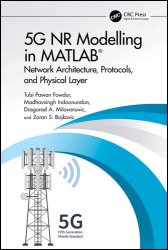 Название
Название: 5G NR Modelling in MATLAB: Network Architecture, Protocols, and Physical Layer
Автор: Tulsi Pawan Fowdur, Madhavsingh Indoonundon, Dragorad A. Milovanovic
Издательство: CRC Press
Год: 2025
Страниц: 450
Язык: английский
Формат: pdf (true)
Размер: 48.8 MB
5G is the fifth generation of cellular technology. It is designed to increase speed, reduce latency, and improve the flexibility of wireless services. 5G New Radio (NR) is the enabler of three key service classes: Enhanced Mobile Broadband (eMBB), Ultra-Reliable Low Latency Communications (URLLC), and Massive Machine-Type Communications (mMTC). The 5G network is expected to deliver a wide range of services that includes eMBB, mMTC, and URLLC. To realize such a diverse set of requirements, the 5G network has evolved as a multilayer network that uses various technological advances to offer an extensive range of wireless services. Several technologies, such as software-defined networking, network function virtualization, edge computing, cloud computing, and small cells, are being integrated into the 5G networks to fulfill the need for diverse requirements.
This book provides a detailed description of the fundamental aspects of 5G. It gives an in-depth coverage of the network architecture of 5G by considering both the network reference point architecture and the service-based architecture. It also describes all the user and control plane protocols including the different standalone and non-standalone architecture options of 5G. The radio access technologies such as the waveforms used in 5G, the multiaccess and duplexing techniques as well as the resource allocation schemes are treated in detail. Additionally, the physical layer signal processing blocks of 5G NR are covered in depth with elaborate numerical examples to illustrate the functioning of each block in the 5G downlink transmitter and receiver chain.
The MathWorks introduced MATLAB’s 5G Toolbox which provides standard-compliant functions and examples for the simulation of the 5G environment. In this book, functions from the toolbox were used to build the 5G NR end-to-end physical layer model for Packet Data Shared Channel (PDSCH) processing and to calculate the PDSCH throughput, Bit Error Rate (BER), and Block Error Rate (BLER). Moreover, MATLAB models of each block have been used to simulate a complete 5G downlink system. A user-friendly Graphical User Interface (GUI)-based simulator has also been developed using MATLAB’s 5G Toolbox, so as to facilitate the physical layer simulation of 5G NR and generate performance results based on common metrics such as the bit error rate and throughput.
The book is organized into five chapters. Chapter 1 presents a chronological evolution of mobile communications standards from 1G to 5G along with the proposed pathway to 6G by 2030. Chapter 2 gives a detailed analysis of the 5G and LTE network architectures with focus on the 5G core and network reference architecture. Chapter 3 elaborates on the software-based architecture of 5G, the 5G protocol stack, and the 5G non-standalone and standalone architecture options. Chapter 4 presents numerical and MATLAB modeling of both the downlink transmitter and receiver of the 5G NR physical layer blocks. Chapter 5 develops a complete user-friendly GUI-based MATLAB simulation to facilitate the simulation of both the downlink transmitters and receivers.
The main originality of this book is the detailed illustration of the 5G NR pre-processing steps as well as Matlab simulation models with explanation on the codes to allow for a seamless understanding of the principles. In general this book is meant for anyone with a basic engineering background who would be interested to acquire a solid foundation in the fundamental concepts of 5G NR.
Скачать 5G NR Modelling in MATLAB: Network Architecture, Protocols, and Physical Layer
[related-news]
[/related-news]